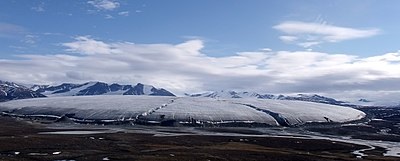|
|
| |
|
|
| |
|
|
|
|
| |
 |
| A Bylot Island
glacier, Sirmilik National Park, Nunavut. This
mountain glacier is one of many coming down from
the interior ice cap on top of the Byam Martin
Mountains. |
Glaciology
Glaciology (from Latin: glacies, "frost, ice", and
Ancient Greek: λόγος, logos, "subject matter"; literally
"study of ice") is the scientific study of glaciers, or
more generally ice and natural phenomena that involve
ice.
Glaciology is an interdisciplinary Earth science that
integrates geophysics, geology, physical geography,
geomorphology, climatology, meteorology, hydrology,
biology, and ecology. The impact of glaciers on people
includes the fields of human geography and anthropology.
The discoveries of water ice on the Moon, Mars, Europa
and Pluto add an extraterrestrial component to the
field, which is referred to as "astroglaciology".
Glaciers can be identified by their geometry and the
relationship to the surrounding topography. There are
two general categories of glaciation which glaciologists
distinguish: alpine glaciation, accumulations or "rivers
of ice" confined to valleys; and continental glaciation,
unrestricted accumulations which once covered much of
the northern continents.
Alpine – ice flows down
the valleys of mountainous areas and forms a tongue of
ice moving towards the plains below. Alpine glaciers
tend to make topography more rugged by adding and
improving the scale of existing features. Various
features include large ravines called cirques and
arêtes, which are ridges where the rims of two cirques
meet.
Continental – an ice sheet
found today, only in high latitudes
(Greenland/Antarctica), thousands of square kilometers
in area and thousands of meters thick. These tend to
smooth out the landscapes. |
|
Overview
A glacier is an extended mass of ice formed from snow
falling and accumulating over a long period of time;
glaciers move very slowly, either descending from high
mountains, as in valley glaciers, or moving outward from
centers of accumulation, as in continental glaciers.
Areas of study within glaciology include glacial history
and the reconstruction of past glaciation. A
glaciologist is a person who studies glaciers. A glacial
geologist studies glacial deposits and glacial erosive
features on the landscape. Glaciology and glacial
geology are key areas of polar research. |
|
Types
Glaciers can be identified by their geometry and the
relationship to the surrounding topography. There are
two general categories of glaciation which glaciologists
distinguish: alpine glaciation, accumulations or "rivers
of ice" confined to valleys; and continental glaciation,
unrestricted accumulations which once covered much of
the northern continents. |
- Alpine – ice flows down the valleys
of mountainous areas and forms a tongue of ice moving
towards the plains below. Alpine glaciers tend to make
topography more rugged by adding and improving the scale
of existing features. Various features include large
ravines called cirques and arêtes, which are ridges
where the rims of two cirques meet.
- Continental – an ice sheet found
today, only in high latitudes (Greenland/Antarctica),
thousands of square kilometers in area and thousands of
meters thick. These tend to smooth out the landscapes.
|
|
Movement
When a glacier is experiencing an input of precipitation
that exceeds the output, the glacier is advancing.
Conversely, if the output from evaporation, sublimation,
melting, and calving exceed the glaciers precipitation
input the glacier is receding. This is referred to as an
interglacial period. During periods where ice is
advancing at an extreme rate, that is typically 100
times faster than what is considered normal, it is
referred to as a surging glacier. During times in which
the input of precipitation to the glacier is equivalent
to the ice lost from calving, evaporation, and melting
of the glacier, there is a steady-state condition.
Within the glacier, the ice has a downward movement in
the accumulation zone and an upwards movement in the
ablation zone. |
|
 Kiddle: Glaciology Kiddle: Glaciology
Wikipedia: Glaciology |
|
|
|
|
|
|
|
|
|
|
|
|
|
|
|
|
Search Fun Easy English |
|
|
|
|
|
|
|
|
|
|
|
|
|
|
|
About
Contact
Copyright
Resources
Site Map |